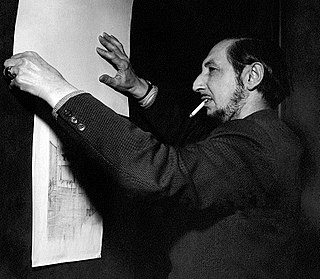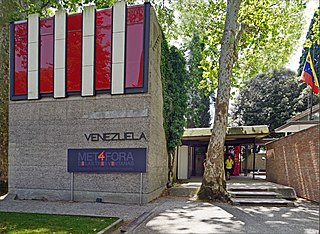
The Venice Biennale is an international cultural exhibition hosted annually in Venice, Italy by the Biennale Foundation. The biennale has been organised every year since 1895, which makes it the oldest of its kind. The main exhibition held in Castello, in the halls of the Arsenale and Biennale Gardens, alternates between art and architecture. The other events hosted by the Foundation—spanning theatre, music, and dance—are held annually in various parts of Venice, whereas the Venice Film Festival takes place at the Lido.

Carlo Scarpa was an Italian architect, influenced by the materials, landscape and the history of Venetian culture, and by Japan. Scarpa translated his interests in history, regionalism, invention, and the techniques of the artist and craftsman into ingenious glass and furniture design.

Sami Rintala is a Finnish architect and artist. He studied architecture at Helsinki University of Technology, completing his studies in 1999. Rintala’s own work is based on narrative and conceptualism. The resulting work is a layered interpretation of the physical, mental and poetic resources of the site.

The Egyptian pavilion is a national pavilion of the Venice Biennale. It houses Egypt's official representation during the Biennale. The building is part of a complex that Brenno Del Giudice designed in 1932 to house Venetian decorative arts on Sant'Elena Island—an expansion of the Biennale from its main Giardini area. The building later served as Switzerland's national pavilion before the country moved to a new pavilion in 1952 and left the building to Egypt. The national pavilions for Serbia and Venice flank the Egyptian pavilion. Egypt's 1995 exhibition won the Biennale's Golden Lion award for best national pavilion.
Frame Contemporary Art Finland is a foundation whose mission is to promote Finnish contemporary art internationally.
The American pavilion is a national pavilion of the Venice Biennale. It houses the United States' official representation during the Biennale.

The German pavilion houses Germany's national representation during the Venice Biennale arts festivals.

The Austrian pavilion is a national pavilion of the Venice Biennale. It houses Austria's official representation during the Biennale.

The French pavilion houses France's national representation during the Venice Biennale arts festivals.

The Australian pavilion houses Australia's national representation during the Venice Biennale arts festivals.

The Canadian pavilion houses Canada's national representation during the Venice Biennale arts festivals.

The Czech and Slovak pavilion houses the national representation of the Czech Republic and Slovakia during the Venice Biennale arts festivals.

The Belgian pavilion houses Belgium's national representation during the Venice Biennale arts festivals.

The Spanish pavilion houses Spain's national representation during the Venice Biennale arts festivals.

The Venezuelan pavilion houses Venezuela's national representation during the Venice Biennale arts festivals. It is located in the Giardini della Biennale.

The Serbian pavilion houses Serbia's national representation during the Venice Biennale arts festivals.

The Romanian pavilion houses Romania's national representation during the Venice Biennale arts festivals.

The Hungarian pavilion houses Hungary's national representation during the Venice Biennale arts festivals.

The Finnish pavilion houses Finland's national representation during the Venice Biennale arts festivals.
The Danish pavilion houses Denmark's national representation during the Venice Biennale arts festivals. The building was designed by Carl Brummer and constructed between 1930 and 1932, and restored and expanded by Peter Koch in the 1950s.



















